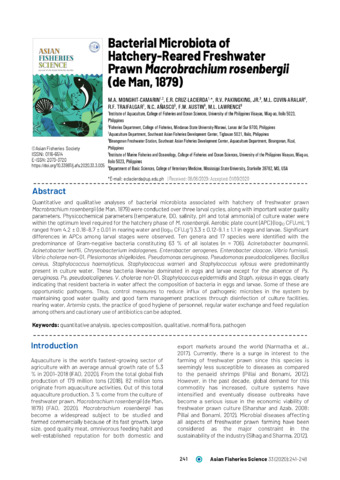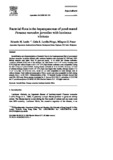Bacterial microbiota of hatchery-reared freshwater prawn Macrobrachium rosenbergii (de Man, 1879)
- Global styles
- MLA
- Vancouver
- Elsevier - Harvard
- APA
- Help

View/
Date
2020-09-30Author
Page views
2,896ASFA keyword
AGROVOC keyword
Metadata
Perlihat publikasi penuh
Share
Abstract
Quantitative and qualitative analyses of bacterial microbiota associated with hatchery of freshwater prawn Macrobrachium rosenbergii (de Man, 1879) were conducted over three larval cycles, along with important water quality parameters. Physicochemical parameters (temperature, DO, salinity, pH and total ammonia) of culture water were within the optimum level required for the hatchery phase of M. rosenbergii. Aerobic plate count (APC) (log10 CFU.mL-1) ranged from 4.2 ± 0.18–8.7 ± 0.01 in rearing water and (log10 CFU.g-1) 3.3 ± 0.12–9.1 ± 1.1 in eggs and larvae. Significant differences in APCs among larval stages were observed. Ten genera and 17 species were identified with the predominance of Gram-negative bacteria constituting 63 % of all isolates (n = 706). Acinetobacter baumannii, Acinetobacter lwoffii, Chryseobacterium indologenes, Enterobacter aerogenes, Enterobacter cloacae, Vibrio furnissii, Vibrio cholerae non-01, Plesiomonas shigelloides, Pseudomonas aeruginosa, Pseudomonas pseudoalcaligenes, Bacillus cereus, Staphylococcus haemolyticus, Staphylococcus warneri and Staphylococcus xylosus were predominantly present in culture water. These bacteria likewise dominated in eggs and larvae except for the absence of Ps. aeruginosa, Ps. pseudoalcaligenes, V. cholerae non-01, Staphylococcus epidermidis and Staph. xylosus in eggs, clearly indicating that resident bacteria in water affect the composition of bacteria in eggs and larvae. Some of these are opportunistic pathogens. Thus, control measures to reduce influx of pathogenic microbes in the system by maintaining good water quality and good farm management practices through disinfection of culture facilities, rearing water, Artemia cysts, the practice of good hygiene of personnel, regular water exchange and feed regulation among others and cautionary use of antibiotics can be adopted.
Suggested Citation
Monghit-Camarin, M.-A., Cruz-Lacierda, E. R., Pakingking, R. V., Jr., Cuvin-Aralar, M. L., Traifalgar, R. F., Añasco, N. C., Austin, F. W., & Lawrence, M. L. (2020). Bacterial microbiota of hatchery-reared freshwater prawn Macrobrachium rosenbergii (de Man, 1879). Asian Fisheries Science , 33(3), 241-248. https://doi.org/10.33997/j.afs.2020.33.3.005
Type
ArticleISSN
0116-6514; 2073-3720Koleksi
- Journal Articles [1258]
Related items
Showing items related by title, author, creator and subject.
-
Morphometric relationship of length and weight of giant tiger prawn Penaeus monodon according to life stage, sex and source
Regression analysis was performed on length–weight and length–length measurements of Penaeus monodon (n=3270 individuals) including carapace length, body length, total length and body (wet) weight of different life stages ... -
Series: Aquaculture extension manual; No. 15 | NACA technology series; No. 5
An improved traditional shrimp culture technique for increasing pond yield
Kungvankij, Pinij; Tiro Jr., Leonardo B.; Pudadera Jr., Beato J.; Potestas, Ihra O.; Chua, Thia-Eng (Network of Aquaculture Centres in Asia, 1986)Details are given of the technology required for an improved method of extensive shrimp (Penaeus monodon) culture, describing the following: grow out facilities, seed supply, pond preparation and management, harvesting and ... -
Bacterial flora in the hepatopancreas of pond-reared Penaeus monodon juveniles with luminous vibriosis
Leaño, Eduardo M.; Lavilla-Pitogo, Celia R.; Paner, Milagros G. (Elsevier, 1998)Quantification and characterization of bacterial flora in the hepatopancreas (hp) of pond-reared Penaeus monodon juveniles affected with luminous bacteria were conducted in 1994 and 1995. Shrimp samples were taken from 23 ...




